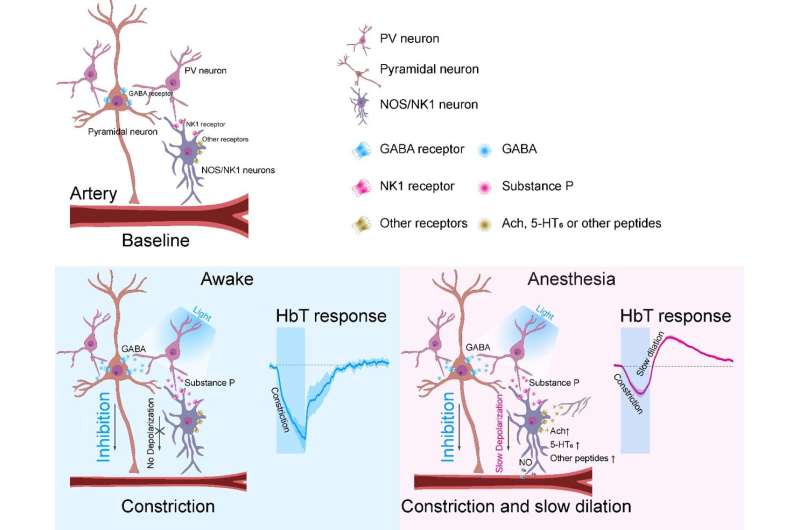This article has been reviewed according to Science X's editorial process and policies. Editors have highlighted the following attributes while ensuring the content's credibility:
fact-checked
peer-reviewed publication
trusted source
proofread
How the brain controls blood flow during sleep

Even while we are asleep, the brain does not rest completely. Surprisingly, the blood flow in a sleeping brain can be greater than when it is in a wakeful state. This allows the brain to remove waste metabolites, which is important to prevent the development and progression of neurological dysfunctions such as dementia. However, the exact mechanism of how the sleeping brain increases blood flow has not been known.
Researchers led by Director Kim Seong-Gi of the Center for Neuroscience Imaging Research within the Institute for Basic Science, South Korea, recently discovered the secrets behind this phenomenon. It was discovered that a type of inhibitory neuron called "parvalbumin (PV) neuron" secretes material called "substance P" that is responsible for vasodilation and control of blood flow to the brain. The study is published in the journal Proceedings of the National Academy of Sciences.
Unlike other inhibitory subtype neurons, it was previously thought that GABAergic PV neurons do not release vasoactive substances, hence their role in blood flow regulation has been controversial. To investigate the role of PV neurons on blood flow regulation, the researchers expressed an opsin protein called channelrhodopsin-2 (ChR2) in mouse PV neurons, and selectively activated PV neurons by light stimulation.
Vascular responses to the activation of PV neurons were measured by wide-field optical imaging and functional magnetic resonance imaging (fMRI). In addition, to identify the role of the PV neurons on blood flow under anesthesia, the researchers used ketamine/xylazine to put the animals to sleep.
The results showed that in lightly anesthetized animals, stimulation of PV neurons induced vasoconstriction and a decline in blood flow. This was followed by a slow vasodilation and an increase in blood flow from 20 seconds up to a minute after cessation of stimulation. On the other hand, in active animals, the PV neuron activity only resulted in a reduction of blood flow. This means that the PV neurons have two different mechanisms for the control of cerebral blood flow depending on whether the brain is awake or asleep.
Furthermore, the researchers also discovered the mechanism behind the observed slow vasodilation after optogenetic stimulation. When the PV neurons are activated, it inhibits the nearby excitatory neurons, which causes vasoconstriction and reduced blood flow. At the same time, it was found that these PV neurons release a peptide called "substance P," which is responsible for the observed slow vasodilation. Substance P activates cells called nitric oxide synthase (nNOS) GABAergic neurons secreting nitrous oxide, a known vasodilator.
The present research finally unveils the factors that control blood flow to the brain during sleep, and the previously unknown role of PV neurons in this process. Director Kim said, "Our research suggested a new direction of research on cerebral blood flow control mechanisms, with possible implications in insomnia and sleep disorder treatment."
More information: Vo, Thanh Tan et al, Parvalbumin interneuron activity drives fast inhibition-induced vasoconstriction followed by slow substance P-mediated vasodilation, Proceedings of the National Academy of Sciences (2023). DOI: 10.1073/pnas.2220777120.





















